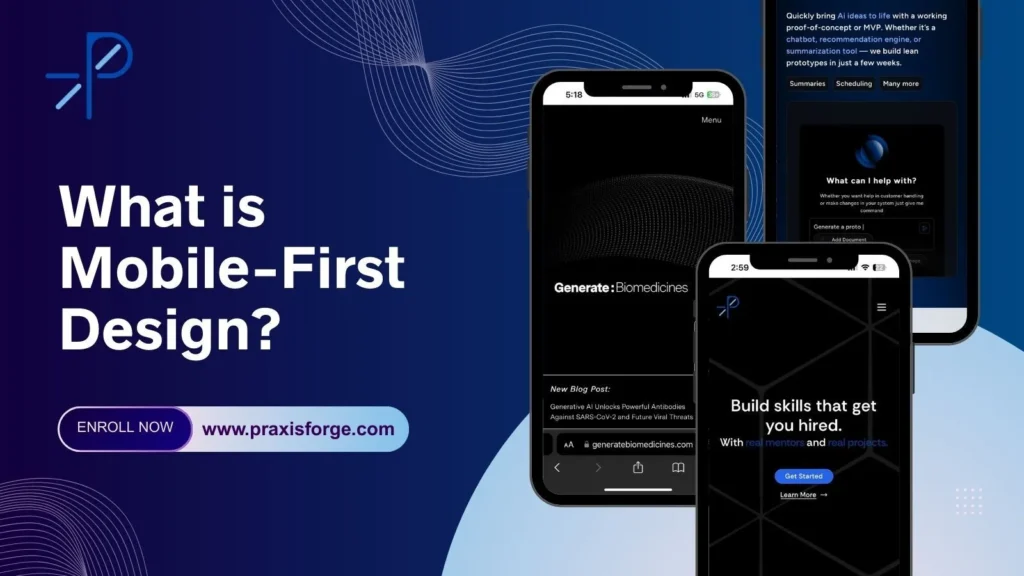
Why Learners Choose Praxis Forge to Master Prompt Engineering
Why Learners Choose Praxis Forge to Master Prompt Engineering IntroductionPrompt Engineering has become one of the most in-demand AI skills

In today’s digital world, most users interact with websites and applications through their smartphones. This shift in behaviour has made mobile-first design one of the most important principles in modern UI & UX strategy. But what exactly does mobile-first design mean, and why should it matter to businesses?
Defining Mobile-First Design
Mobile-first design is a design philosophy where websites and applications are created for smaller screens first, before being adapted for larger devices like tablets and desktops. Instead of shrinking down a desktop design to fit a phone, designers start with the core mobile experience and then scale upward.
This approach ensures that content, navigation, and functionality are optimized for the devices users rely on most.
Why Mobile-First Design Matters for UI & UX
Mobile-first ensures that the most essential features and content are presented clearly, without clutter. By focusing on the small screen, UI & UX designers are forced to prioritize usability, which improves the overall experience across all devices.
Google prioritizes mobile-friendly websites in search rankings. A mobile-first approach not only improves usability but also helps businesses gain better visibility in search results Google Mobile-First Indexing Guide.
Mobile-first design emphasizes lightweight layouts, responsive images, and simplified interactions. This leads to faster loading, which is critical for both user satisfaction and SEO performance. According to Think with Google, a delay of even a few seconds can increase bounce rates significantly.
With mobile usage continuing to grow worldwide, investing in mobile-first design ensures your digital products are built for the long term.
Key Principles of Mobile-First UI & UX
Examples of Mobile-First in Action
Think of apps like Instagram, Uber, or Airbnb. Their entire UI & UX is tailored to mobile-first interactions—simple navigation, clear visuals, and easy user flows. Websites adopting the same principles see higher engagement and lower bounce rates.
Why Businesses Should Embrace Mobile-First Design
For businesses, mobile-first design is more than a trend—it’s a necessity. Customers are making decisions, purchases, and bookings directly from their phones. A poorly optimized mobile experience can mean lost opportunities and reduced brand trust.
That’s why leading organizations partner with Praxis Forge to create UI & UX solutions that are mobile-first, scalable, and tailored to business goals.
Conclusion
Mobile-first design is about putting users at the centre of your digital strategy. By designing for mobile first, businesses can deliver fast, intuitive, and accessible experiences that perform well across devices.
If your business is ready to transform its UI & UX and embrace mobile-first design, explore how Praxis Forge can help you build digital products that truly connect with your audience.
FAQs About Mobile-First Design
Q1. What’s the difference between mobile-first and responsive design?
Mobile-first means designing for mobile devices first and then adapting the layout for larger screens. Responsive design ensures layouts adapt fluidly to any screen size. The two approaches work together, but mobile-first sets priorities for smaller screens from the start.
Q2. Why is mobile-first important for SEO?
Since Google uses mobile-first indexing, it primarily evaluates the mobile version of your site for rankings. If your mobile experience is poor, your overall SEO performance may suffer Search Engine Journal on Mobile-First.
Q3. Does mobile-first design impact eCommerce conversions?
Yes. Studies show that mobile-optimized experiences lead to higher conversions by reducing friction in checkout and making navigation intuitive.
Q4. How do I know if my website follows mobile-first principles?
You can use tools like Google’s Mobile-Friendly Test to evaluate your site and identify improvements.
Q5. Can Praxis Forge help with mobile-first design?
Absolutely. At Praxis Forge, we specialize in creating mobile-first UI & UX designs that improve usability, SEO performance, and customer engagement.

Why Learners Choose Praxis Forge to Master Prompt Engineering IntroductionPrompt Engineering has become one of the most in-demand AI skills

Prompt Engineering Career Roadmap: Skills Tools and Job Roles Table of Contents Introduction What Is Prompt Engineering? Why Prompt Engineering

What Is Prompt Engineering? A Beginner’s Guide to the Future of AI Jobs Artificial Intelligence (AI) is transforming the way

Python vs JavaScript: Which Language Should You Learn First? Introduction Choosing your first programming language can shape your entire tech

How Praxis Forge Teaches Prompt Engineering Differently from Other Platforms Table of Contents What Is Prompt Engineering and Why It

Praxis Forge vs Generic Online Courses: Which One Really Gets You Hired? Table of Contents The Problem with Generic Online